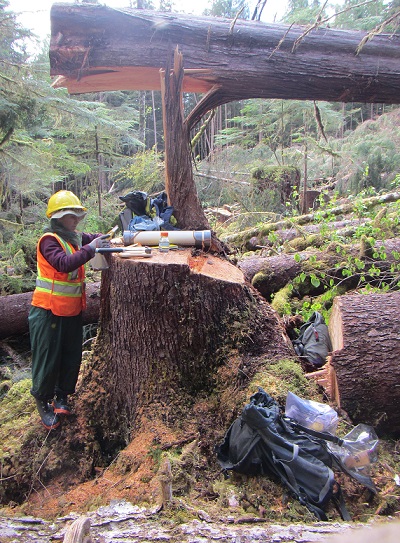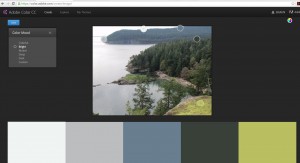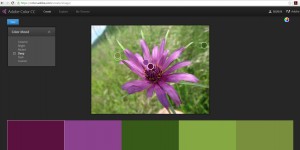Heading to Haida Gwaii: Part I of an MSc
Sampling for my Master’s project began in May 2016 when Lea and I drove Bean (our lab truck) out of Vancouver towards Haida Gwaii, with lots of unnecessary gear and too much cream cheese. Our mp3/ipod hookup (which is certainly not considered unnecessary gear) broke 45 minutes into the trip, leaving us with no music except intermittent radio. What followed was an epic 28-hr set of travel conversations, over three days, that I could spend this entire blog post recounting – including a history of each of our entire lives, year-by-year in total detail, since birth. The high point of the trip out was the precipitous mountain scenery between New Hazleton and Prince Rupert; the low point was Lea eating all the M&Ms in the trailmix (REALLY, LEA?).
We arrived at Moresby Camp on Moresby Island, where we camped while we sampled at a nearby clearcut. The campsite sits on the end of a little peninsula into a long inlet from the east coast of Haida Gwaii, at the mouth of a river and surrounded by the highest mountains on the islands. Company consisted of bugs, occasional rain, one massive bear, and a rowdy crack-of-dawn party of birds in the estuary. In the morning, Bill from Taan Forestry took us out to the cutblock (thanks, Bill!). Here Lea won honours with distinction by remembering her bug net. I forgot mine, and regretted it. Over the next five days we searched for 10 or so tall Sitka spruce to sample. We took samples of needles or buds from the top of each tree, as well as samples of the inner bark from the base of each tree. We also counted rings, took pictures, GPSed things, measured tree heights and diameters, sawed stumps, swatted flies, fell off tree trunks, fell onto tree trunks, fell under tree trunks, and generally worked hard.
If you’ve made it two paragraphs into this post without quitting, you’re too committed to quit when I explain my research topic (even if I bore your socks off – not that I will). So, the research: I’m studying somatic mutation, the same kind of mutations that in humans cause cancer. Somatic mutations are mutations (changes to a cell’s DNA sequence) that happen in the body cells of an organism instead of in reproductive cells like the precursors to sperm or pollen. And unlike in humans, somatic mutations can be inherited in trees. Because somatic mutations happen when cells divide, and because trees can be large, we expect there are lots of somatic mutations in trees.
What’s interesting about somatic mutations is… a lot of things. Mutations are the raw material for evolution, so if trees boost up their mutation rates with extra somatic mutations, they could adapt more quickly and more closely to local environmental conditions (temperature, precipitation). This could be important for adaptation to changing climates, too. Similarly, long-lived trees need to evolve defenses against the short-lived insects that eat them. Maybe somatic mutations help trees overcome their own long generation times (which slow down evolution) and keep pace with fast-evolving insects. There are other interesting points, too – somatic mutations have to do with ageing, and the evolution of mating systems, and horticultural varieties (pink grapefruits!), and competition between branches and buds, and selection within individual trees.
No one knows for sure how many somatic mutations there are, in a tree’s lifetime, so I’m going to try to find out. The idea is to sequence samples from the top of the tree and compare them with samples from the bottom of the tree. Differences between the two are somatic mutations. Improvements in sequencing technology mean that these mutations, which happen maybe once in a million or ten million base pairs, should now be possible to detect — we hope. Luckily, for the sake of fun, field technology lags behind sequencing technology, and actually obtaining the samples involves a lot of mucking around in the cutblock with envelopes and a small annoying electric saw.
A few days into sampling we were going a bit crazy. “Smell me,” said Lea, after an overly-long day of tumbling around the cutblock. “I smell good.” I thought that was unlikely, and I refused to comply. But she’d been spending most of her spare time bathing down at the river, because I’d been unmercifully crushing her at board games – and so her options seemed to be either bathing or re-reading Harry Potter while giving me dirty looks. I may be exaggerating the ill-will board games generate, but I’m sure she smelled much better than me. Anyway, clearly a rest day was needed. Our rest day was an all-day hike up Mt. Moresby, which included some good views, some snow, and some interesting plants.
Well, after finding nine suitable trees to sample from (each whimsically named), we took the overnight ferry and drove the long drive back to Prince Rupert. And now (I hope) you’re clamoring for a Part II to complete Part I of this blog post. Well you’ll have to wait. Not because I’m too lazy to finish it (which is probably why Joane divided her post in two parts), but because sampling Part II hasn’t happened yet. But it promises to be lots of fun, too – we’re planning to climb the biggest spruce we can possibly find… I’ll tell you about it sometime.








